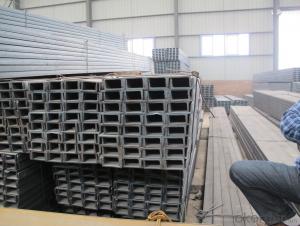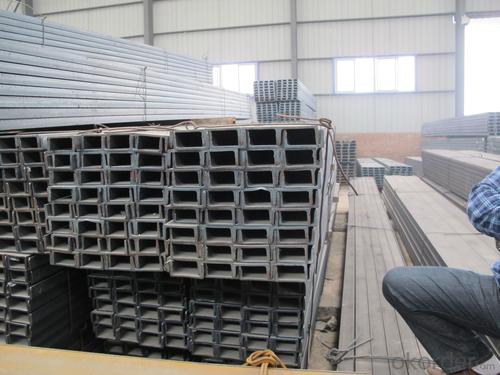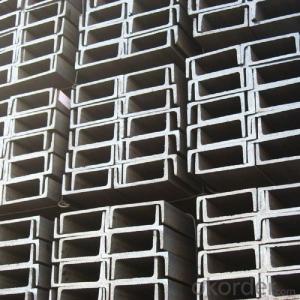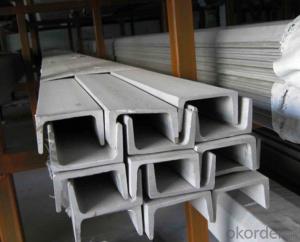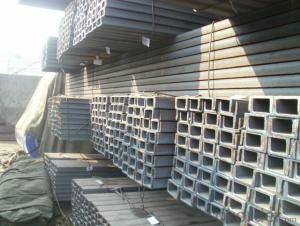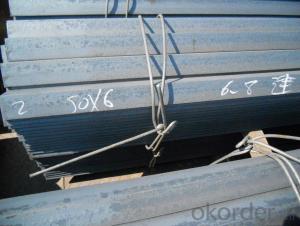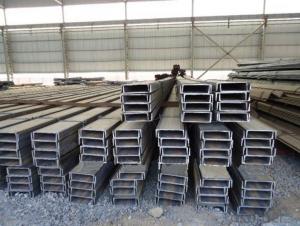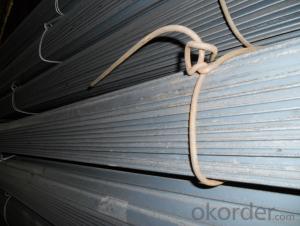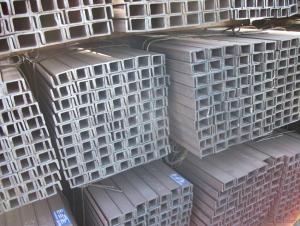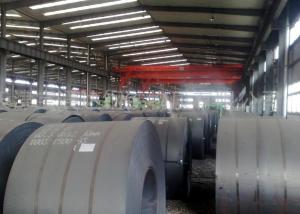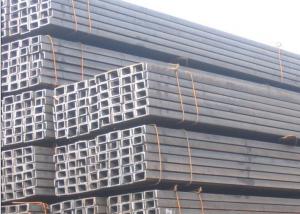Hot Rolled Channel Carbon Steel Hign Quality
- Loading Port:
- China Main Port
- Payment Terms:
- TT or LC
- Min Order Qty:
- -
- Supply Capability:
- -
OKorder Service Pledge
OKorder Financial Service
You Might Also Like
Product Description:
OKorder is offering STEEL CHANNEL at great prices with worldwide shipping. Our supplier is a world-class manufacturer of steel, with our products utilized the world over. OKorder annually supplies products to European, North American and Asian markets. We provide quotations within 24 hours of receiving an inquiry and guarantee competitive prices.
Product Applications:
1.The JIS channel can be devided into two kinds, namely common channel steel and light channel steel. The sizes of hot rolled common channel steel range from 5# to 40#. Meanwhile, the channel steel can be divided into cold forming sectional equal channel steel, cold forming sectional unequal channel steel, cold forming inner edge channel steel and outer edge channel steel.
2.The JIS channel is usually used for arch-itechtural structure, and they could be welded in order to support or hang a vari-ety of facilities. They are also usually used in combination with I beam. The channel steel with sizes under 14# is usually applied to construction engineering, as purline, while the channel steel with sizes above 16# is more likely to be used in building vehicle chassis structure and mechanical structure. Furthermore, the channel steel in sizes above 30# are target at building bridge structure, as tension bar.
3.In a word, the channel steel must possess perfect welding property, riveting property and mechanical property and so on.
Product Advantages:
OKorder's STEEL CHANNELare durable, strong, and resist corrosion.
Main Product Features:
· Premium quality
· Prompt delivery & seaworthy packing (30 days after receiving deposit)
· Corrosion resistance
· Can be recycled and reused
· Mill test certification
· Professional Service
· Competitive pricing
Product Specifications:
Standard | GB/JIS |
Material Grade | Q235,SS400 |
Technique: | Hot Rolled |
Sizes as per chinese standard: | 50*37*4.5mm - 300*89*11.5mm |
Sizes as per japanese standard: | 50*25*3mm – 200*80*7.5mm |
Length: | 6meter, 9meter, 12meter |
Note: 1.we are also competent to provide our customers other MS Channel based on other sizes according to customer’s requirements.
2. The length of our ms channel could be cut into other meters as per customer’s requirements. For example, the channel in 6meters could be cut into 5.8meters in order to be fit in the 20ft container.
GB U CHANNEL | Standard | Sectional | Dimension |
| Mass: |
| (mm) | (mm) | (mm) | (mm) |
|
50X37 | 50 | 37 | 4.50 | 7.0 | 5.438 |
63X40 | 63 | 40 | 4.80 | 7.5 | 6.634 |
80x43 | 80 | 43 | 5.00 | 8.0 | 8.045 |
|
|
|
|
|
|
100x48 | 100 | 48 | 5.30 | 8.5 | 10.007 |
120x53 | 120 | 53 | 5.50 | 9.0 | 12.059 |
140x58 | 140 | 58 | 6.00 | 9.5 | 14.535 |
140x60 | 140 | 60 | 8.00 | 9.5 | 16.733 |
|
|
|
|
|
|
160x63 | 160 | 63 | 6.50 | 10.0 | 17.240 |
160x65 | 160 | 65 | 8.50 | 10.0 | 19.752 |
|
|
|
|
|
|
180x68 | 180 | 68 | 7.00 | 10.5 | 20.174 |
180x70 | 180 | 70 | 9.00 | 10.5 | 23.000 |
|
|
|
|
|
|
200x73 | 200 | 73 | 7.00 | 11.0 | 22.637 |
200x75 | 200 | 75 | 9.00 | 11.0 | 25.777 |
|
|
|
|
|
|
220x77 | 220 | 77 | 7.00 | 11.5 | 24.999 |
220x79 | 220 | 79 | 9.00 | 11.5 | 28.453 |
|
|
|
|
|
|
250x78 | 250 | 78 | 7.00 | 12.0 | 27.410 |
250x80 | 250 | 80 | 9.00 | 12.0 | 31.335 |
250x82 | 250 | 82 | 11.00 | 12.0 | 35.260 |
|
|
|
|
| |
280x82 | 280 | 82 | 7.50 | 12.5 | 31.427 |
280x84 | 280 | 84 | 9.50 | 12.5 | 35.823 |
280x86 | 280 | 86 | 11.50 | 12.5 | 40.219 |
|
|
|
|
|
|
300x85 | 300 | 85 | 7.50 | 13.5 | 34.463 |
300x87 | 300 | 87 | 9.50 | 13.5 | 39.173 |
300x89 | 300 | 89 | 11.50 | 13.5 | 43.883 |
Alloy No | Grade | Element(%) | ||||
C | Mn | S | P | Si | ||
Q235 | B | 0.12-0.20 | 0.3-0.7 | ≦0.045 | ≦0.045 | ≦0.3 |
Note: we are able to present our customers relevant SGS test report for mechanical property of MS Channel as customer’s request.
Package & Delivery of MS Channel:1.The hot rolled channel steel will be packed in bundle with steel wire at each end of every bundle and color marking in order to help the customer to recognize his goods more easily at sight.
2. And the hot rolled channel steel could be loaded into 20ft or 40ft container, or by bulk cargo.If the weight of each bundle reaches more than 3.5 mt, the loading by break bulk cargo should be choosed.When the weight of each bundle reaches less than 3mt, the loading by container should be choosed.
3.As for the transportaion from mill to loading port, the truck will be usually used. And the maximum quantity for each truck is 40mt.
4.All in all, we could do in accordance with customer's request.
FAQ:
Q1: Why buy Materials & Equipment from OKorder.com?
A1: All products offered byOKorder.com are carefully selected from China's most reliable manufacturing enterprises. Through its ISO certifications, OKorder.com adheres to the highest standards and a commitment to supply chain safety and customer satisfaction.
Q2: How do we guarantee the quality of our products?
A2: We have established an advanced quality management system which conducts strict quality tests at every step, from raw materials to the final product. At the same time, we provide extensive follow-up service assurances as required.
Q3: What makes stainless steel stainless?
A3: Stainless steel must contain at least 10.5 % chromium. It is this element that reacts with the oxygen in the air to form a complex chrome-oxide surface layer that is invisible but strong enough to prevent further oxygen from "staining" (rusting) the surface. Higher levels of chromium and the addition of other alloying elements such as nickel and molybdenum enhance this surface layer and improve the corrosion resistance of the stainless material.
Images:
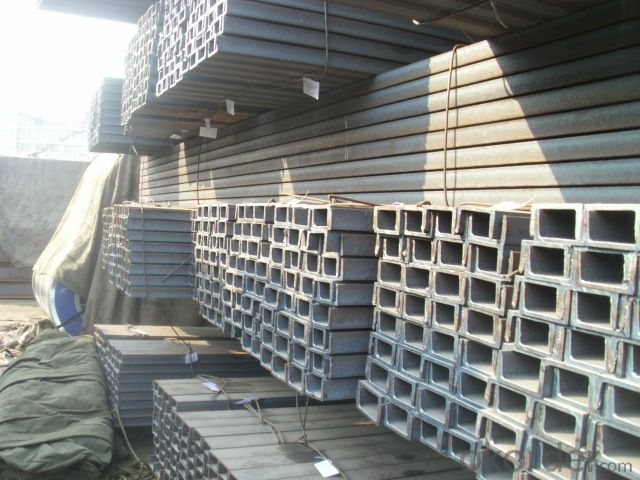
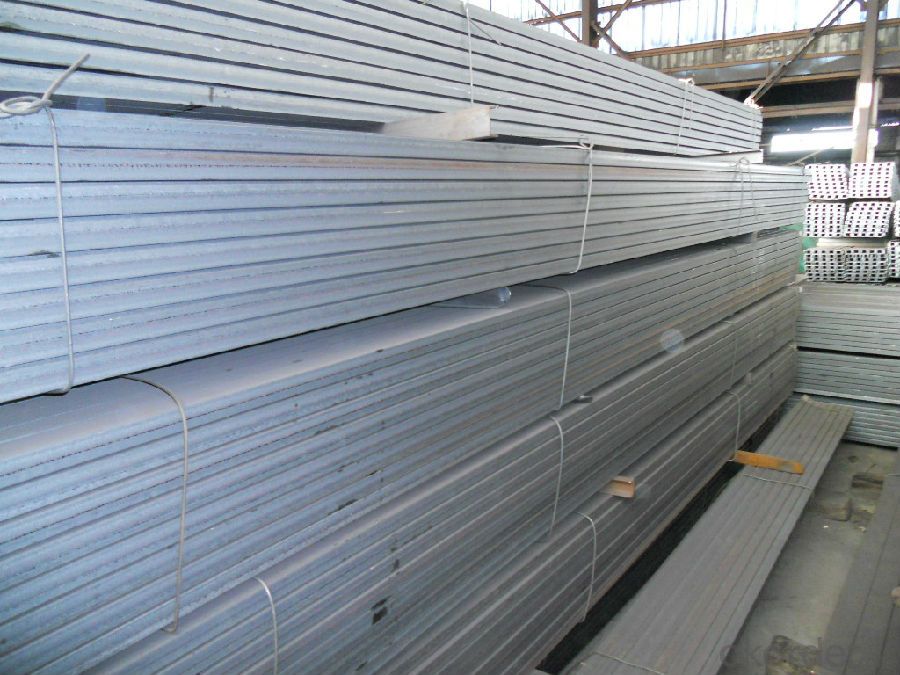
- Q: Are steel channels suitable for modular construction?
- Yes, steel channels are suitable for modular construction. They are commonly used in modular construction due to their strength, durability, and versatility. Steel channels provide structural support and can be easily assembled and connected to create modular units. Additionally, steel channels can withstand heavy loads and provide stability, making them an ideal choice for modular construction projects.
- Q: Can steel channels be used in signage applications?
- Steel channels are a viable option for signage applications. They serve as a sturdy and stable structural support for signage panels. These channels are frequently utilized in outdoor signage projects, including billboards, highway signs, and store signs. Depending on the sign's design and dimensions, steel channels can be installed either horizontally or vertically. Moreover, they possess durability and resistance to weather elements, ensuring the longevity of outdoor signage. Furthermore, steel channels can be effortlessly tailored and manufactured to meet specific signage demands, encompassing size, shape, and color. In conclusion, steel channels offer versatility and dependability for a wide range of signage applications.
- Q: How do steel channels contribute to sustainable construction?
- Steel channels play a vital role in promoting sustainable construction through various means: 1. Enhanced Durability: Steel channels exhibit exceptional durability and corrosion resistance, resulting in an extended lifespan compared to alternative construction materials. This not only reduces the need for frequent repairs and replacements but also minimizes waste generation and lessens environmental repercussions. 2. Recyclable Nature: Globally recognized as one of the most recyclable materials, steel channels can be effortlessly recycled without compromising their properties. Incorporating recycled steel channels into construction projects diminishes the demand for new steel production, thus conserving natural resources and mitigating greenhouse gas emissions associated with manufacturing fresh steel. 3. Structural Efficiency: Steel channels boast an extraordinary strength-to-weight ratio, allowing for the creation of robust and stable structures while utilizing less material. This heightened efficiency leads to reduced material consumption, lower transportation costs, and decreased energy requirements during the construction phase. 4. Design Versatility: The versatility of steel channels enables architects and engineers to craft innovative and sustainable structures. This adaptability facilitates the optimization of building layouts, efficient space utilization, and integration of energy-efficient systems, such as solar panels or rainwater harvesting systems. 5. Energy Conservation: Steel channels can serve as integral components of energy-efficient construction systems, like insulated wall panels or roof trusses. These systems enhance a building's thermal performance, reducing energy consumption for heating and cooling purposes. Furthermore, steel channels provide support for the installation of energy-saving technologies, including LED lighting or advanced smart building management systems. 6. Resilience against Natural Disasters: Steel channels exhibit exceptional resistance against extreme weather events such as hurricanes, earthquakes, and fires. Utilizing steel channels in construction enhances the structural integrity of a building, rendering it more resilient and significantly reducing the risk of damage or collapse during such calamities. In conclusion, steel channels contribute significantly to sustainable construction by offering durability, recyclability, structural efficiency, design flexibility, energy efficiency, and resilience against natural disasters. These attributes collectively contribute to minimizing environmental impacts, conserving valuable resources, and establishing long-lasting, sustainable edifices.
- Q: Overhanging Scaffold; channel spacing
- The longitudinal horizontal rod shall be on the inside of the vertical pole, and its length shall not be less than 3 spans. Longitudinal butt joints should be staggered, two adjacent longitudinal joints should not be set in a synchronous or within the same span, not synchronous or different across the two adjacent joints staggered horizontal distance should not be less than 500mm, each jointcenter distance from the primary node is no larger than the vertical distance of 1/3. A bar two segment height should not exceed 2cm, the horizontal bar full Changping flatness can not exceed the total length of the scaffold of 1/300, and is no more than 10m.
- Q: What are the different methods of joining steel channels together?
- Steel channels can be joined together using various methods, each with its own advantages and limitations. Welding is a commonly used technique that involves melting and fusing the edges of the channels. While it creates a strong and durable joint, it requires skilled welders and specialized equipment. Welding techniques, such as arc welding, MIG welding, TIG welding, or spot welding, can be employed depending on the specific requirements. Alternatively, bolting can be used by connecting the channels using bolts and nuts. This method is relatively simple and allows for easy disassembly and adjustments, making it suitable for applications that require flexibility. However, it may not offer the same level of strength as welding, and additional reinforcement might be necessary in high-stress situations. Riveting is another option, which involves using metal fasteners called rivets to join the channels. Although it has been widely used in the past, it is less common nowadays due to the availability of more efficient joining techniques. Riveting can provide a strong joint, but it requires special tools and skills for proper installation. Adhesive bonding is a method that utilizes specialized adhesives to join the channels together. It offers several advantages, including non-invasiveness, a smooth finish, and even stress distribution across the joint. Adhesive bonding can be a suitable option when other methods are impractical or undesirable. Ultimately, the choice of joining method for steel channels depends on factors such as application requirements, desired strength and durability, available resources, and the expertise of personnel involved. Careful evaluation of these factors and consultation with professionals is crucial for determining the most appropriate method for a specific project.
- Q: What are the different fabrication techniques used for steel channels?
- There are various fabrication techniques used for manufacturing steel channels, each with its own advantages and applications. Some of the commonly used techniques include hot rolling, cold rolling, and press braking. Hot rolling is a popular method where steel is heated above its recrystallization temperature and then passed through a series of rollers to shape it into the desired channel profile. This technique allows for high production rates and can produce channels with consistent dimensions and excellent surface finish. Cold rolling, on the other hand, involves the deformation of steel at room temperature. The process starts with hot-rolled steel, which is subsequently passed through rollers under high pressure. Cold rolling can result in greater dimensional accuracy, improved surface finish, and increased strength compared to hot rolling. Press braking is another fabrication technique used for steel channels. In this method, a hydraulic press is used to bend the steel sheet into the desired channel shape. This technique is particularly suitable for producing channels with complex shapes or when only a small quantity of channels is required. Other fabrication techniques for steel channels include laser cutting, plasma cutting, and welding. Laser cutting uses a high-powered laser beam to cut the steel sheet into the desired channel profile accurately. Plasma cutting, on the other hand, utilizes a jet of hot plasma to cut through the steel. Both techniques offer precise and fast cutting processes. Welding is often used to join multiple steel sections together to create larger and more complex channel structures. Various welding methods, such as MIG (Metal Inert Gas) welding, TIG (Tungsten Inert Gas) welding, and arc welding, are employed based on the specific requirements of the project. Overall, the choice of fabrication technique for steel channels depends on factors such as the desired channel profile, production volume, dimensional accuracy, surface finish, and project requirements. By utilizing these different techniques, manufacturers can create steel channels that meet a wide range of applications in construction, manufacturing, and other industries.
- Q: What are the different types of steel channel connections for mezzanine floors?
- There are several different types of steel channel connections that are commonly used for mezzanine floors. These connections are designed to provide stability and support to the structure, ensuring that the mezzanine floor is secure and can bear the required load. 1. Bolted Connections: Bolted connections are one of the most common types of steel channel connections used in mezzanine floors. These connections involve the use of bolts and nuts to join the steel channels together. Bolted connections are strong and can be easily disassembled and reassembled if needed. 2. Welded Connections: Welded connections involve the use of welding to join the steel channels together. This type of connection provides excellent strength and rigidity. Welded connections are permanent and cannot be easily disassembled, so they are often used when a mezzanine floor is intended to be a permanent structure. 3. Clip Connections: Clip connections are another popular type of steel channel connection for mezzanine floors. These connections involve the use of clips that are secured onto the steel channels, providing a secure and easy-to-install connection. Clip connections are versatile and can be easily adjusted or modified if needed. 4. Slip-Fit Connections: Slip-fit connections are a type of connection that involves inserting one steel channel into another, creating a tight and secure fit. These connections are often used when the mezzanine floor needs to be adjustable or expandable. Slip-fit connections are easy to install and can be disassembled and reassembled if needed. 5. Gusset Plate Connections: Gusset plate connections involve the use of additional steel plates, known as gusset plates, to connect the steel channels together. These plates are typically welded or bolted to the steel channels, providing added strength and stability to the connection. Gusset plate connections are commonly used in heavy-duty mezzanine floor applications. It is important to note that the specific type of steel channel connection used for a mezzanine floor will depend on factors such as the load requirements, structural design, and installation preferences. Consulting with a structural engineer or a professional contractor is advisable to determine the most suitable type of steel channel connection for a specific mezzanine floor project.
- Q: Can steel channels be used in DIY projects?
- Yes, steel channels can be used in DIY projects. Steel channels are versatile and strong, making them suitable for various applications such as building structures, shelving units, and furniture. They can be easily welded, cut, or drilled to fit specific project requirements, making them a popular choice among DIY enthusiasts and professionals alike.
- Q: Can steel channels be used for supporting exterior shading devices?
- Yes, steel channels can be used for supporting exterior shading devices. Steel channels are commonly used in construction for their strength and durability, and they can provide a sturdy framework for supporting shading devices such as awnings, canopies, or louvers. The channels can be securely attached to the building's exterior and provide a stable base for the shading device. Additionally, steel channels can be customized and fabricated to meet specific design requirements, allowing for flexibility in the installation of exterior shading devices.
- Q: The role of channel?
- Channel steel is used in building construction and vehicle manufacture, including hot rolled channel steel and bent channel steel. Hot rolled channel steel can be divided into two types: ordinary and light. The channel steel specifications are from 5 to 40, i.e., the corresponding height is 5 to 40cm. At the same height, the light channel steel has narrower legs, thinner waist and lighter weight than ordinary channel steel. Channel steel is widely used in the manufacture of vehicles and various metal structures.
Send your message to us
Hot Rolled Channel Carbon Steel Hign Quality
- Loading Port:
- China Main Port
- Payment Terms:
- TT or LC
- Min Order Qty:
- -
- Supply Capability:
- -
OKorder Service Pledge
OKorder Financial Service
Similar products
Hot products
Hot Searches
Related keywords
